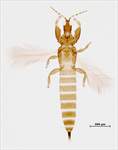Generic diagnosis
Medium sized, macropterous Phlaeothripinae, varying greatly in structure and size. Head longer than wide, genae distinctively constricted at base, without stout setae; vertex transverely striate; mouth-cone short, maxillary stylets retracted half way to postocular setae and one third of head width apart; maxillary bridge not visible. Antennae 8-segmented; segment III with 3 sense cones, IV with 4 sense cones, VIII constricted at base. Pronotum of large individuals slightly elongate; with 4 pairs of major setae, anteromarginals small; notopleural sutures complete. Prosternal basantra present but small, ferna large, mesopresternum of 2 lateral triangles; metathoracic sternopleural sutures absent. Metanotum weakly reticulate, one pair of setae medially. Fore tarsal tooth present in both sexes. Fore tibiae inner margin with small tubercle. Fore femur with median tubercle, elongate in large individuals. Fore wings constricted medially, with duplicated cilia. Pelta triangular to bell-shaped; tergites II‒VII each with two pairs of sigmoid wing-retaining setae and several curved accessory setae; tergite IX setae as long as tube; tube shorter than head, straight-sided. Male tergite IX setae S2 short and stout; sternite VIII without pore plate.
Nomenclatural data
Euoplothrips Hood, 1918: 140 Type species Euoplothrips bagnalli Hood, 1918, by monotypy.
There are six species recognised in this genus (ThripsWiki, 2022).
Australian species
Euoplothrips bagnalli Hood, 1918: 141
Euoplothrips platypodae Marullo, 2001: 97
Relationship data
Within the Phlaeothripinae, this genus is considered to be a member of the Tribe Haplothripini.
Distribution data
Of the species listed in this genus, the type species is from subtropical eastern Australia and New Guinea, whereas platypodae is known only from northwestern Australia. Three members of this genus are from different Pacific Islands, but a sixth species that was described from India is of doubtful relationships.
Biological data
Species of Euoplothrips have been found breeding within leaf galls induced by other thrips species (Mound & Minaei 2007), where they probably act as kleptoparasites. In Australia, bagnalli has been found in leaf galls induced by various Phlaeothripinae on Acronychia, Alyxia, Callistemon, Ficus, Piper, Smilax and Tetrastigma. Moreover, platypodae is known to live within the leaf galls of Gynaikothrips platypodae on Ficus platypoda.
References
Marullo R (2001) Gall thrips of the Austro-Pacific genus Euoplothrips Hood (Thysanoptera), with a new species from Australia. Insect Systematics and Evolution 32: 93–98.
Mound LA & Minaei K (2007) Australian insects of the Haplothrips lineage (Thysanoptera – Phlaeothripinae). Journal of Natural History 41: 2919–2978.
ThripsWiki (2022) ThripsWiki - providing information on the World's thrips. Available from: http://thrips.info/wiki/ (Accessed 15.iii.2022)




